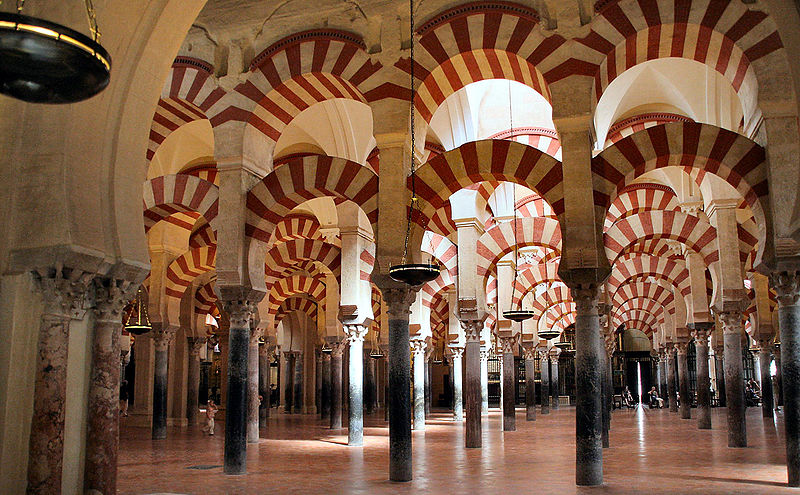Datoteka:Mosque of Cordoba.jpg

Vidi sliku u punoj veličini (3.000 × 1.857 piksela, veličina datoteke: 1,49 MB, MIME tip: image/jpeg)
| Ova je datoteka sa Zajedničkog poslužitelja i mogu je rabiti drugi projekti. Opis s njezine stranice s opisom datoteke prikazan je ispod. |
| OpisMosque of Cordoba.jpg |
The Mezquita (Mosque) of Cordoba is a Roman Catholic cathedral and former mosque situated in the Andalusian city of Córdoba, Spain. Under the rule of Islam, it was built as the second-largest mosque in the world, and is perhaps the most accomplished monument of the Umayyad dynasty of Cordoba. After the Spanish Reconquista, it was transformed into a church, and some of the Islamic columns and arches were replaced by a basilica in early Baroque style. Today it houses the main church of the diocese of Cordoba in Spain. The construction of the Mezquita started in approximately 600 A.D. as a Christian Visigothic church. Later, the Mezquita was reworked for over two centuries to refashion it as a mosque, starting in 784 A.D. under the supervision of the first Muslim Emir Abd ar-Rahman I, who used it as an adjunct to his palace and named it to honor his wife. The land was bought by the Emir from the previous owners. It is believed that the site included the Visigothic cathedral of St. Vincent. When the forces of Tariq ibn-Ziyad first occupied Córdoba in 711, the Christian cathedral was suppressed. Several explanations have been proposed to explain the mosque's unorthodox orientation. Some have suggested the mihrab faces south because the foundations of the mosque are borrowed from the old Roman and Visigoth constructions. Others contend that Abd ar-Rahman oriented the mihrab southward as if he were still in the Ummayyad capital of Damascus and not in exile. The mosque underwent numerous subsequent changes: Abd ar-Rahman III ordered a new minaret, while Al-Hakam II, in 961, enlarged the plan of the building and enriched the mihrab. The last of the reforms was carried out by Al-Mansur Ibn Abi Aamir in 987. It was the most magnificent of the more than 1,000 mosques in the city and was at one time the second largest mosque in the Muslim world. It was connected to the Caliph's palace by a raised walk-way, mosques within the palaces being the tradition for the islamic rulers of all times. The city in which it was built was subject to frequent invasion and each conquering wave added their own mark to the architecture. The building is most notable for its giant arches, with over 1,000 columns of jasper, onyx, marble, and granite. These were made from pieces of the Roman temple which had occupied the site previously, as well as other destroyed Roman buildings. The double arches, pictured above, were a new introduction to architecture, and helped support the tremendous weight of the higher ceilings. The double arches consist of a lower horseshoe arch and an upper semi-circular arch. The Mezquita also features richly gilded prayer niches. A centrally located honey-combed dome has beautiful blue tiles decorated with stars. The mihrab is a masterpiece of architectural art, with geometric and flowing designs of plants. The Mezquita reached its current dimensions in 987 A.D. with the completion of the outer naves and orange tree courtyard. Patio de los Naranjos, inside the Mezquita.In 1236, Cordoba was recaptured from the Muslim army by King Ferdinand III of Castile and the mosque was reconsecrated a Christian church. Alfonso X oversaw the construction of the Villaviciosa Chapel and the Royal Chapel within the structure of the mosque. The kings who followed added further Christian features: Enrique II rebuilt the chapel in the 14th century. The most significant alteration was the construction of a Renaissance cathedral nave in the middle of the structure. It was constructed by permission of Carlos V, king of united Spain. Its reversion to a Christian church (officially the Cathedral of the Assumption of the Virgin) may have helped to preserve it when the Spanish Inquisition was most active. Artisans and architects continued to add to the existing structure until the late 18th century. |
|||
| Datum | ||||
| Izvor | originally posted to Flickr as Mezquita (Mosque) of Cordoba | |||
| Autor | James (Jim) Gordon | |||
| Dopuštenje (Naknadna uporaba ove datoteke) |
Ova datoteka je licencirana pod Creative Commons Imenovanje 2.0 nelokaliziranom licencijom.
|
|||
| Ostale inačice |
|
Opisi
Predmeti prikazani u ovoj datoteci
motiv
Određene vrijednosti bez stavke na projektu Wikipodatci
30. listopada 2007
Povijest datoteke
Kliknite na datum/vrijeme kako biste vidjeli datoteku kakva je tada bila.
| Datum/Vrijeme | Minijatura | Dimenzije | Suradnik | Komentar | |
|---|---|---|---|---|---|
| sadašnja | 10:17, 20. veljače 2009. |  | 3.000 × 1.857 (1,49 MB) | Flickr upload bot | Uploaded from http://flickr.com/photo/31910792@N05/3137188520 using Flickr upload bot |
Uporaba datoteke
Nijedna stranica ne rabi ovu datoteku.
Globalna uporaba datoteke
Sljedeći wikiji rabe ovu datoteku:
- Uporaba na en.wikipedia.org
Metapodatci
Ova datoteka sadržava dodatne podatke koje je vjerojatno dodala digitalna kamera ili skener u procesu snimanja odnosno digitalizacije. Ako je datoteka mijenjana, podatci možda nisu u skladu sa stvarnim stanjem.
| Orijentacija kadra | Normalno |
|---|---|
| Vodoravna razlučivost | 300 dpi |
| Okomita razlučivost | 300 dpi |
| Korišteni softver | Adobe Photoshop 7.0 |
| Datum posljednje promjene datoteke | 16:22, 30. listopada 2007. |
| Kolor prostor | Nekalibrirano |

